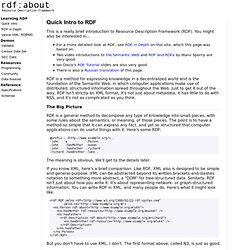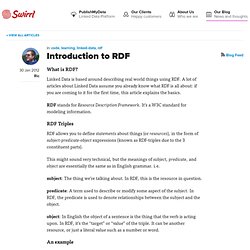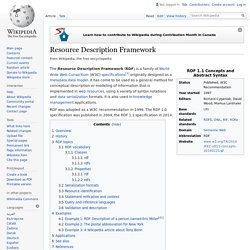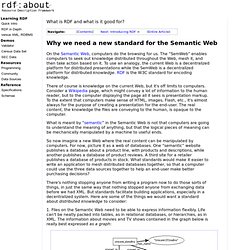

Quick Intro to RDF. Quick Intro to RDF This is a really brief introduction to Resource Description Framework (RDF).

You might also be interested in... For a more detailed look at RDF, see RDF in Depth on this site, which this page was based on.Two video introductions to the Semantic Web and RDF and RDFa by Manu Sporny are very good.Ian Davis's RDF Tutorial slides are also very good.There is also a Russian translation of this page. RDF is a method for expressing knowledge in a decentralized world and is the foundation of the Semantic Web, in which computer applications make use of distributed, structured information spread throughout the Web. Just to get it out of the way, RDF isn't strictly an XML format, it's not just about metadata, it has little to do with RSS, and it's not as complicated as you think. The Big Picture RDF is a general method to decompose any type of knowledge into small pieces, with some rules about the semantics, or meaning, of those pieces. @prefix : < .
An Introduction to RDF. What is RDF?

Linked Data is based around describing real world things using RDF. A lot of articles about Linked Data assume you already know what RDF is all about: if you are coming to it for the first time, this article explains the basics. RDF stands for Resource Description Framework. It’s a W3C standard for modeling information. RDF Triples RDF allows you to define statements about things (or resources), in the form of subject-predicate-object expressions (known as RDF-triples due to the 3 constituent parts). This might sound very technical, but the meanings of subject, predicate, and object are essentially the same as in English grammar. i.e. subject: The thing we’re talking about.
Predicate: A term used to describe or modify some aspect of the subject. Object: In English the object of a sentence is the thing that the verb is acting upon. An example That was all a bit hand-wavey, so let’s use an example to make it a bit clearer. Ric’s blog can be found at ricroberts.com Blob and Line. Resource Description Framework. The Resource Description Framework (RDF) is a family of World Wide Web Consortium (W3C) specifications[1] originally designed as a metadata data model.

It has come to be used as a general method for conceptual description or modeling of information that is implemented in web resources, using a variety of syntax notations and data serialization formats. It is also used in knowledge management applications. RDF was adopted as a W3C recommendation in 1999. The RDF 1.0 specification was published in 2004, the RDF 1.1 specification in 2014. Overview[edit] RDF is an abstract model with several serialization formats (i.e. file formats), so the particular encoding for resources or triples varies from format to format. As RDFS and OWL demonstrate, one can build additional ontology languages upon RDF. History[edit] The W3C published a specification of RDF's data model and an XML serialization as a recommendation in February 1999.[9]
What is RDF and what is it good for? What is RDF and what is it good for?

On the Semantic Web, computers do the browsing for us. The “SemWeb” enables computers to seek out knowledge distributed throughout the Web, mesh it, and then take action based on it. To use an analogy, the current Web is a decentralized platform for distributed presentations while the SemWeb is a decentralized platform for distributed knowledge. RDF is the W3C standard for encoding knowledge. There of course is knowledge on the current Web, but it's off limits to computers. What is meant by “semantic” in the Semantic Web is not that computers are going to understand the meaning of anything, but that the logical pieces of meaning can be mechanically manipulated by a machine to useful ends. So now imagine a new Web where the real content can be manipulated by computers.
There's nothing stopping anyone from writing a program now to do those sorts of things, in just the same way that nothing stopped anyone from exchanging data before we had XML.